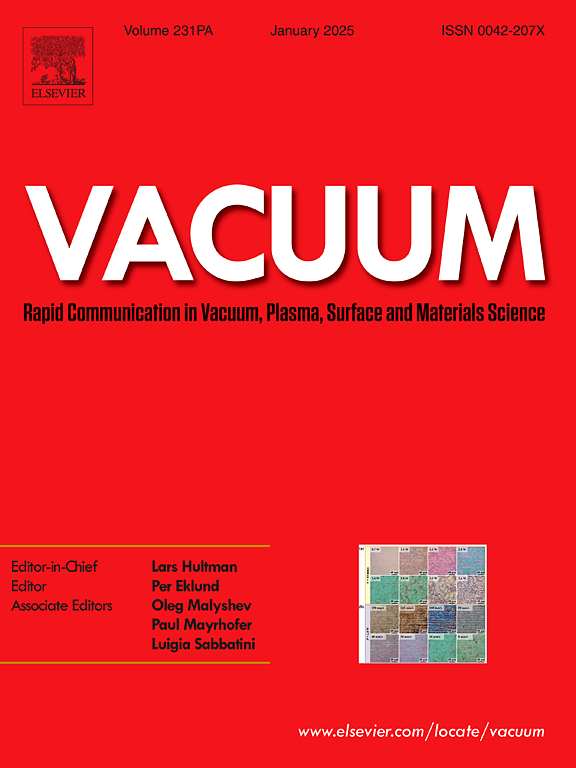Influence of water vapor on Nujol adsorption and desorption on quartz and calcite surfaces: A near-ambient pressure X-ray photoelectron spectroscopy and ambient atomic force microscopy study
IF 3.9
2区 材料科学
Q2 MATERIALS SCIENCE, MULTIDISCIPLINARY
引用次数: 0
Abstract
The stability of oil/substrate interaction upon external stimuli is a critical issue for enhanced oil recovery (EOR) processes and catalytic applications. In this study, we address how the Nujol films behaves on well-defined SiO2(001) and CaCO(104) surfaces against water vapor pressure (2 mbar) and ultra-high vacuum (UHV) environment (10−10 mbar) by in-situ near-ambient pressure X-ray photoelectron spectroscopy measurement (NAP-XPS) and ex-situ by atomic force microscopy (AFM). The specimen conditioning with Nujol resulted in a film of 2 nm on SiO2 and up 4 nm on CaCO. The chemical composition of Nujol/SiO2 interface does not vary significantly against treatment, although its topography passes from continuous to cluster like in DW/Nujol/SiO2 interface. In Nujol/CaCO interface oil component reduces by: (i) 20% in UHV and (ii) 60% after controlled exposure to DW vapor pressure (2 mbar). The modification of interface chemical composition is reflected into the alteration of Nujol film topography on CaCO that varies from continuous to fragmented film after 12 h in UHV and substantially reorganizes itself after exposure to p(HO) = 2 mbar. Our results highlight the role of water in reshaping the oil-oxide interface under controlled environmental conditions and its relevance in oil removal process.

水蒸气对Nujol在石英和方解石表面吸附和解吸的影响:近环境压力x射线光电子能谱和环境原子力显微镜研究
在外界刺激下,油/基质相互作用的稳定性是提高原油采收率(EOR)工艺和催化应用的关键问题。在这项研究中,我们通过原位近环境压力x射线光电子能谱测量(napp - xps)和原子力显微镜(AFM)研究了Nujol薄膜在定义良好的SiO2(001)和CaCO3(104)表面上对水蒸气压(2 mbar)和超高真空(10 - 10 mbar)环境(10 - 10 mbar)的表现。用Nujol对样品进行调理后,在SiO2上形成约2 nm的薄膜,在CaCO3上形成高达4 nm的薄膜。与DW/Nujol/SiO2界面相似,Nujol/SiO2界面形貌由连续向簇状转变,但其化学成分在不同处理条件下变化不大。在Nujol/CaCO3界面中,油成分减少:(i)在特高压下减少20%,(ii)受控暴露于DW蒸汽压(2 mbar)后减少60%。界面化学成分的改变反映在CaCO3上的Nujol膜形貌的改变上,在UHV作用12 h后由连续膜变为破碎膜,在p(H2O) = 2 mbar作用后基本重新组织。我们的研究结果强调了水在受控环境条件下重塑油-氧化物界面的作用及其在除油过程中的相关性。
本文章由计算机程序翻译,如有差异,请以英文原文为准。
求助全文
约1分钟内获得全文
求助全文
来源期刊

Vacuum
工程技术-材料科学:综合
CiteScore
6.80
自引率
17.50%
发文量
0
审稿时长
34 days
期刊介绍:
Vacuum is an international rapid publications journal with a focus on short communication. All papers are peer-reviewed, with the review process for short communication geared towards very fast turnaround times. The journal also published full research papers, thematic issues and selected papers from leading conferences.
A report in Vacuum should represent a major advance in an area that involves a controlled environment at pressures of one atmosphere or below.
The scope of the journal includes:
1. Vacuum; original developments in vacuum pumping and instrumentation, vacuum measurement, vacuum gas dynamics, gas-surface interactions, surface treatment for UHV applications and low outgassing, vacuum melting, sintering, and vacuum metrology. Technology and solutions for large-scale facilities (e.g., particle accelerators and fusion devices). New instrumentation ( e.g., detectors and electron microscopes).
2. Plasma science; advances in PVD, CVD, plasma-assisted CVD, ion sources, deposition processes and analysis.
3. Surface science; surface engineering, surface chemistry, surface analysis, crystal growth, ion-surface interactions and etching, nanometer-scale processing, surface modification.
4. Materials science; novel functional or structural materials. Metals, ceramics, and polymers. Experiments, simulations, and modelling for understanding structure-property relationships. Thin films and coatings. Nanostructures and ion implantation.
 求助内容:
求助内容: 应助结果提醒方式:
应助结果提醒方式:


